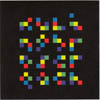 Although Stephen Mallinder has been probably the least prolific of his Cabaret Voltaire cohorts, his work outside of that classic band has never been lacking in quality. This album, originally released in 1999 with Shane Norton, demonstrates how his post-CV trajectory moved towards the dancier end of the spectrum and manages to mostly sound fresh, even within a genre that tries to reinvent itself every few months.
Although Stephen Mallinder has been probably the least prolific of his Cabaret Voltaire cohorts, his work outside of that classic band has never been lacking in quality. This album, originally released in 1999 with Shane Norton, demonstrates how his post-CV trajectory moved towards the dancier end of the spectrum and manages to mostly sound fresh, even within a genre that tries to reinvent itself every few months.
Like the latter CV albums, there is a distinctive dance-centric sound to Creach, perhaps even more than the work of his then bandmate Richard H. Kirk.While Kirk was never shy about throwing down dancefloor friendly beats, he was more apt to wrap them in paranoid political imagery and conspiracy-laden samples.
Songs such as "Systematic Intro" and "Where's James" convey a more timeless vibe, like the deep reverberating bass and layered pseudo-ethnic rhythms in a mix that is almost over the top in intensity."Where's James" mixes distorted beats, scratches and looped melodies make it the catchiest track on here, especially when listened in a non-dancing capacity.
While the drum and bass tinged "To Rock the Rhythm" and "Times Square" sound more of the era than some of the other songs, they're so well done, especially the transition from restrained aggression into laid-back funk of "To Rock the Rhythm".Similarly, the thumping bass and hip-hop rhythms of "Need a Cab" sound like they're from the late 1990s, but in a good way.
However, there are moments in which the duo lean into sounds that are surprisingly stale and stagnant.The housey synth stabs and vocal samples on "Systematic Hipster" seem almost cliché amongst the otherwise creative dubby bass and overdriven synth leads."Space Junk" may be the worst offender, from its stiff attempt at funk to perhaps the most glaring issue:Paula Abdul vocal samples.
This reissue appends one unreleased track, "Time," which fits right in with its strong bass line and subtle complexity.I never heard the album in its original incarnation, and I didn’t realize it was a bonus track, which shows how well it fits in with the other songs.In addition to the extra track, the artwork gets a needed overhaul, trashing the extremely late '90s "techno alien" graphic for a subtle Designers Republic reimaging of the band name and album title.
While Ku-Ling Brothers mined more conventional electronic sounds than Richard H. Kirk's various pseudonyms, they were definitely intended for the dance floor.Kirk's music could definitely be danced to, but I always imaged it as being more suited as backgrounds for writing manifestos or cleaning guns in case the New World Order occurs.Even though it's intended for the club, Creach has enough complexity and variation in sound to make it as stimulating for the mind as it is for the body.
samples:
 
Read More


